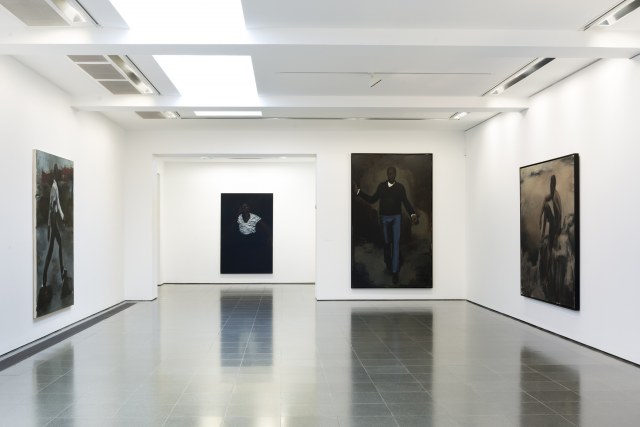


Lynette Yiadom-Boakye: Verses After Dusk; Installation view, Serpentine Gallery (2 June - 13 September 2015); Image © readsreads.info 2015
Just to mix things up a bit I am flagging not one but two shows this week. Both are painting shows and both have opened in the last few days; there are no connections between them but for anyone paying attention to developments in painting, they are required viewing.
Peter Davies is presenting a group of new paintings that signal a significant shift in his work. Those who visited Frieze New York last month will have had a taster of these cool and handsome works, but this is the first opportunity to consider them as a larger group. Davies graduated from Goldsmiths in 1996, a generation behind the YBAs, but was included in the époque-making Sensation exhibition at the Royal Academy in 1997. His early text based paintings were rainbow-coloured, seemingly stream-of-consciousness lists of his art world heroes and heroines; The Hip One Hundred, for example, presented a tongue-in-cheek league table of artists in a format familiar from pop chart count downs or cheap Saturday night TV. Purely abstract works followed that picked up the same palette of colours and were composed of similarly obsessive, densely serried freehand lines, like candy-coloured geological cross-sections. His last show with The Approach in 2012 presented monochrome canvasses, once again distinguished by the characteristic fine line compositions that reached almost towards the weave of textiles. Compelling in their poise as much as the remarkable physical labour evident in their making. None of this prepares you for the new body of work.
Each canvas in RITES features large geometric forms, all sharing the same, understated tones of grey. Rectangles and discs appear to be stacked one on the other with a sensation of mass and weight that entirely belies their apparent compositional simplicity. The visceral physicality stems from the manner of their making: each composition begins as paper collage, and the artist’s act of cutting each element from paper and assembling them is the origin of this sense of three-dimensionality. You could almost believe they are the work of a sculptor. One can enjoy teasing out all kinds of connections to Modernist abstraction but these are emphatically contemporary paintings by an artist still urgently interrogating the act of painting itself.
Lynette Yiadom-Boakye’s exhibition at the Serpentine is the most substantial presentation of her work in the UK to date. In spite of her 2012 Chisenhale show, and the occasional appearance of her work at auction since then, for many this will be their first chance to get to grips with an artist who is a unique and distinct new voice in figuration. Pictures of people: singly, often in pairs but also in groups, Yiadom-Boakye conjures images that powerfully evoke narratives that remain always just beyond the grasp of the viewer. Landscapes are indeterminate: there are beaches, or river edges, mountaintops, and most frequently dark interiors. Her figures wear elegant but generic clothing that betrays no specificity about place or time. But there is always, clearly something going on.
A painting like A Toast to the Health Of, 2011, for example, presents two girls, or young women in bathing costumes, or maybe underwear, poised on the edge of a reed-fringed river, holding hands and apparently about to leap in to the water. Like all her characters, these girls are loosely rendered – there is less concern for accuracy than for capturing the tension between the figures, the sense of quick movement arrested. The girls’ clasped hands are at the centre of the canvas, and it is perhaps this relationship that is the subject of the work, a freeze-frame of the moment just before they leap together.
I forgot to mention that all Yiadom-Boakye’s subjects are imaginary. Although some of the portraits so powerfully suggest an individual soul looking back at the viewer, no actual people are depicted. The painter is closely engaged with the long traditions of portraiture in painting. Rembrandt, Sargent, Manet and Goya are close at hand, and through them the use of portraiture in a history of class, commerce and political power. She also makes urgent the question of who is looking at whom. All her subjects are black; more often than not they are beautiful men. In the (really excellent) publication that accompanies the show, Glenn Ligon discusses a series of paintings depicting male figures all wearing striped Breton shirts. Musing on their identity, as read from their poses, Ligon writes:
“(….) I’ve never seen her in stripes, but to invent a figure you have to start somewhere, so she must have started with herself, from there building a scaffold on which to hang things like blackness or masculinity, things that are fugitive and subject to revision.” I can’t top that as an analysis.
East or West – get these shows to the top of your to-do list.
The approach, 1st Floor, 47 Approach Road, Bethnal Green, London E2 9LY. Exhibition continues until 19th July 2015. Open Wednesday – Sunday 12.00–18.00 or by appointment. www.theapproach.co.uk
Serpentine Gallery, Kensington Gardens, London, W2 3XA. Exhibition continues until 13th September 2015. Open Tuesday - Sunday 10.00 - 18.00. www.serpentinegalleries